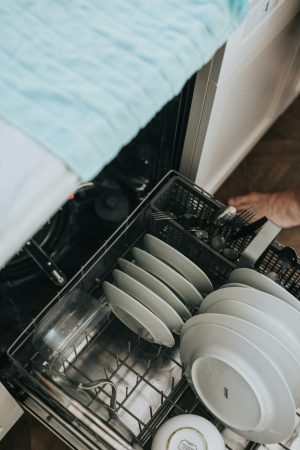Your dishwasher works tirelessly to keep your dishes clean, but have you ever stopped to consider that it may need a thorough clean, too? Neglecting your dishwasher’s maintenance can lead to a buildup of grime and food waste, affecting its performance and the cleanliness of your dishes.
The good news? Cleaning your dishwasher isn’t as complicated as one would think, especially if you are following the regular maintenance tips below. Here’s how to clean your dishwasher fast and effectively.

Unsplash / Nathan Dumlao
Why you need to clean your dishwasher
Regular cleaning maintains your dishwasher’s performance and prolongs its lifespan. It removes soap scum, residue, and food debris – this will keep your dishes looking sparkling clean and prevents unpleasant odours from lingering in your dishwasher. The first sign of poor maintenance is a smelly appliance.
Everything you need to clean your dishwasher
To get started, make sure you have everything on this checklist at home:
- Soft-bristle brush
- Flexible wire
- Old toothbrush
- Sponge
- Microfiber cloths
- Distilled white vinegar
- Baking soda
- Dish soap
- Stainless steel cleaning product (for stainless steel interiors)
- Olive oil or baby oil (for stainless steel)
- Dishwasher cleaner (optional)
Clean dishwasher’s strainer weekly
Weekly maintenance is an important step in keeping your dishwasher clean. Start by removing the bottom rack and inspecting the strainer for trapped debris. Use a soft-bristle brush dipped in vinegar to scrub away any buildup that you find, ensuring every nook and cranny is clean. Once done, replace the bottom rack, and you’re done.
Wipe down door and buttons once a week
Another weekly maintenance chore for keeping your dishwasher in top shape, is to give the door and control buttons a good wipe down. Use mild dish soap (Sunlight is our go-to) and a microfiber cloth to remove any splatters and stains. For buttons or dials, use an old toothbrush dipped in soapy water to clean around them thoroughly.

Freepik
How to deep clean your dishwasher once a month
For a monthly deep cleanse of your dishwasher, start by placing a bowl of distilled white vinegar on the top rack of the empty dishwasher once a month. Run a hot water cycle without detergent, allowing the acidity of the vinegar to break down soap scum and residue effectively.
After the vinegar cycle, sprinkle baking soda on the dishwasher floor to neutralise odours. Run a short hot water rinse cycle to remove any lingering smells, leaving your dishwasher fresh and clean.
Cleaning your dishwasher’s filter
Following the pattern of once a month, remove and soak the dishwasher filter in soapy water to loosen any buildup. Use an old toothbrush to scrub away debris, then rinse well before reinstalling the filter.
Maintaining components of your dishwasher
There are a few smaller maintenance tasks you can do to really maximise the lifespan and effectiveness of your dishwasher:
Spray arms clean: To ensure proper water distribution, remove the racks from your dishwasher and clean the spray arms. Use flexible wire to clear debris from the spray arm holes, ensuring they are free from clogs.
Clean rubber seals: To prevent mold and mildew, wipe down rubber seals around the interior opening and door edges with a sponge dipped in vinegar, once a month. This step may seem simple and even skippable, but it helps to maintain a hygienic dishwasher.

Freepik
If all else fails, bring in the big guns
For a more intensive clean that requires more care than you can muster with a vinegar soak, consider using a dishwasher cleaner designed to remove tough stains and odours. Follow the manufacturer’s instructions for best results. Usually, you will need a rinse aid, and dishwasher salt.
Never clean a dishwasher with bleach
Lastly, avoid using bleach to clean your dishwasher, especially if it has stainless steel interiors. Bleach can damage the appliance and should be avoided to ensure its longevity.
Sticking to a regular cleaning schedule and rinsing dishes before loading will help in keeping your dishwasher in good working condition. Remember to avoid overloading to ensure proper water circulation!
ALSO SEE: KITCHEN HACKS: THE CORRECT WAY TO LOAD YOUR DISHWASHER
Feature Image: Freepik
Article originally compiled by Savana Douglas for Woman&Home.

